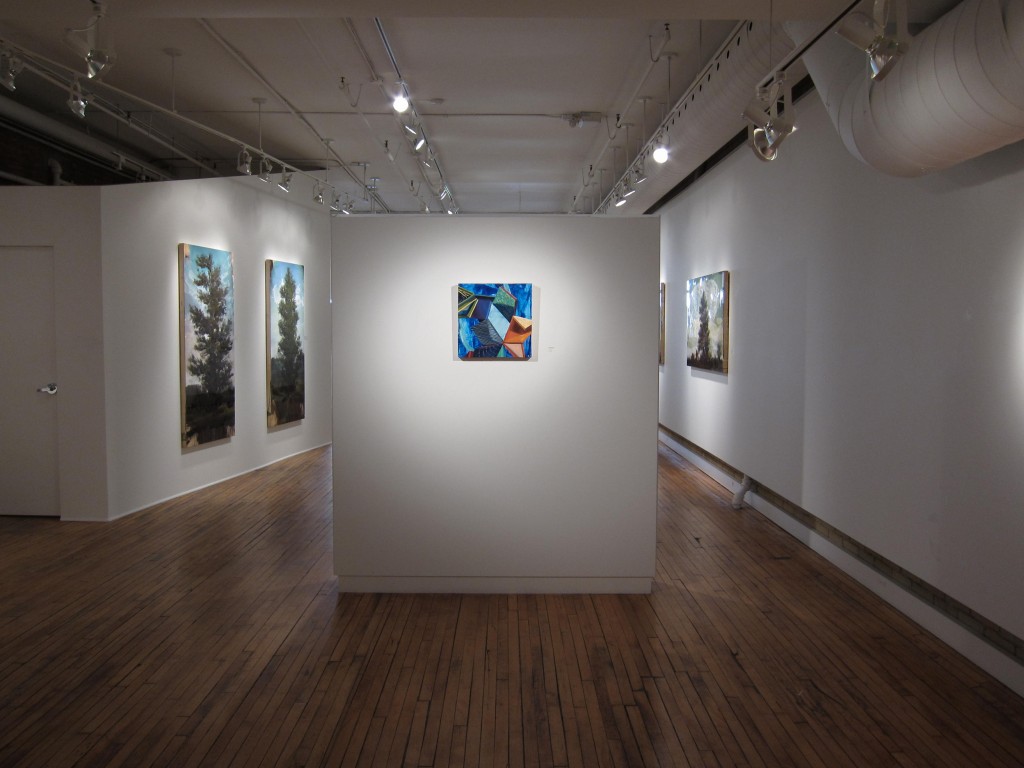Peter Hoffer and Rachel MacFarlane at Nicholas Metivier Gallery
An exhibition by two contrasting, but in some ways complementary artists. Both paint very much in the present, with Peter Hoffer arching to nostalgia and Rachel MacFarlane coming off as futuristic. While both avoid the depiction of the human figure, Hoffer delivers pastoral scenes untrammeled by human activity. Evidence of nature with MacFarlane has all but vanished in the clutter of human production.
Peter Hoffer
Peter Hoffer’s paintings at Metivier Gallery struck me as landscapes from “Nowhere.” They evinced a gnawing sense that fragments of specific places had been ground and pulverized to serve the compositional restraints of the artist’s formulaic approach. The positive fruits of the strategy, of course, is the yield of a coherent body of work.
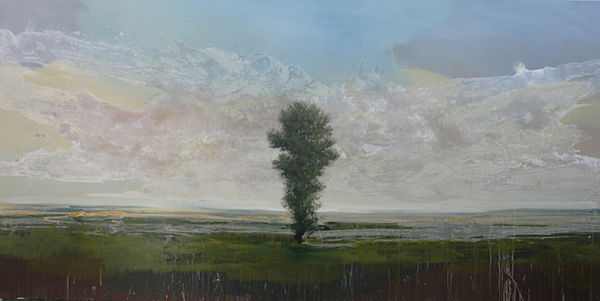 Peter Hoffer, Guardian, 2012, oil, acrylic, and epoxy on board, 60 x 120 inches
Peter Hoffer, Guardian, 2012, oil, acrylic, and epoxy on board, 60 x 120 inches
Given the swiftly-painted, drippy handling of the paint in many of the works, a sense of tranquility and peace ruled over all. It brought to mind the pre-Romantic landscapes of Claude Lorrain, with the absence, in this case, of human traces. Hoffer’s brand of the pastoral though, tends to the generic and bland. This may be deliberate. As such, the works may serve as soothing backdrops to the cacophony that generally engulf urban dwellers.
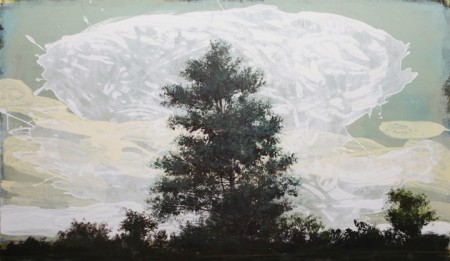 Peter Hoffer, Cedar 2012, oil, acrylic, epoxy on panel, 36 x 60 inches
Peter Hoffer, Cedar 2012, oil, acrylic, epoxy on panel, 36 x 60 inches
The titles of Hoffer’s paintings “Spartan,” “Insignia,” “Estate,” and “Guardian,” hint at a management and control of nature. This takes the form of a taming or idealization of it, as the title “Pastoral” suggests. With the pairing of “Cartier” and “Epitaph” a narrative may be construed; Europeans land in the New World and end up trashing an unspoiled wilderness.
Without doubt, Hoffer maintains a close identification with nature. The evidence is written into the artist’s working method, which is essentially a miming of its cycles. The clouds in “Epitaph,” for example, have not been painted exactly; they are literally splashes of liquidity, or latent rain. The green and brown earth pigments form rivulets that run down patches of unpainted board, a simulation of roots being watered. To complete the work, every drip and splash is sealed by a liberal coating of resin, essentially entombing it. The gloss does the job of preserving and bringing to life the elements.
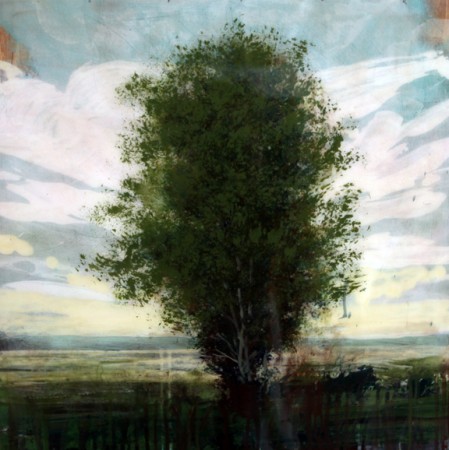 Peter Hoffer, Baron, 2012, oil, acrylic, epoxy on board, 24 x 24 inches
Peter Hoffer, Baron, 2012, oil, acrylic, epoxy on board, 24 x 24 inches
To an artist, the use of resin is seductive. Each millimetre of a work is suffused with light, bestowing to it a hyper-clarity. In Hoffer’s case it’s a wink to the 19th century Salon-era custom of the vernissage, where paintings were varnished prior to an art opening to imbue them with
freshness.
For some time now, a sizable number of contemporary art practitioners have been infected by a resin-mania, suggesting a return of the Salon in some fashion on a global scale. It seems that avant-garde strategies are being made acedemic on a wholesale basis, as white-cube markets
proliferate, catering to a polyphony of tastes.
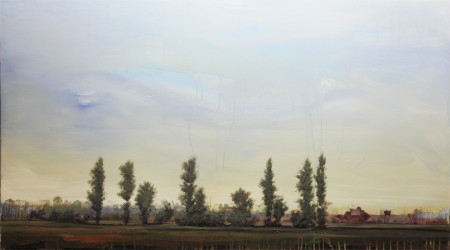 Peter Hoffer, Estate, 2012, oil and resin on board, 36 x 72 inches
Peter Hoffer, Estate, 2012, oil and resin on board, 36 x 72 inches
John Constable’s admiration of Claude Lorrain may in some measure apply to Peter Hoffer’s current landscape oeuvre at Metivier, “All is lovely – all amiable – all is amenity and repose; the calm sunshine of the heart.”
Rachel MacFarlane
To view Rachel MacFarlane’s paintings at Metivier is to enter an other-worldly kaleidoscope of acid-doused forms. Here and there are recognizable fragments; a chair, a rod, the corner of a box, or the edge of something that cannot be pinpointed. The more we look, the less important the literal references become. The eye is taken on a restless voyage to alien terrain, unpopulated and strangely vacant.
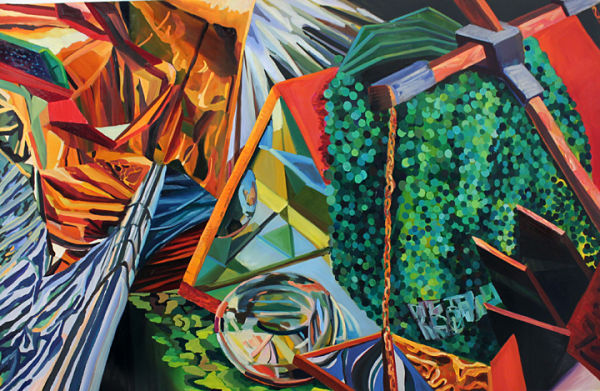 Rachel MacFarlane, Hide out in the Strange Heath, 2012, oil on mylar, 35 x 55 1/2 inches
Rachel MacFarlane, Hide out in the Strange Heath, 2012, oil on mylar, 35 x 55 1/2 inches
What we see in the artist’s work might be interpreted as the rubble of modern utopian hopes. Something that was once ordered has now lapsed into chaos. Where is nature? Where is humankind for that matter? The sensibility here is not merely post-modern, but possibly post-human.
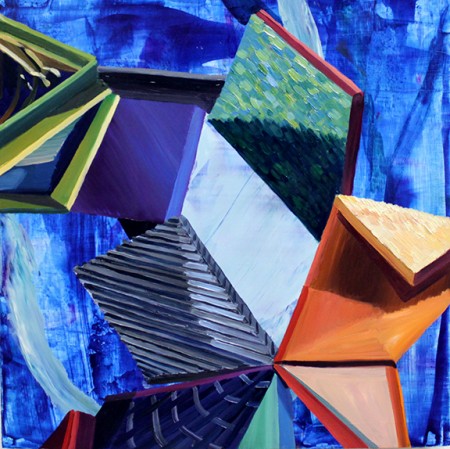 Rachel MacFarlane, Tumbling, 2013, Oil on Wood Panel, 16 x 16 inches
Rachel MacFarlane, Tumbling, 2013, Oil on Wood Panel, 16 x 16 inches
Inspiration for MacFarlane’s forms are her own collection of small maquettes, garbage and scraps really. With the judicious arranging and lighting of the props, work on the actual paintings begins for the artist. Since the scale of objects in the completed works is hard to fix
for the viewer, the received images tend to drift from the retinal to an inner mind space.
Hyper-saturated colour patternings contribute an aura of the hallucinatory. I would describe the experience as chemical thought traces of forgotten events, or flashbacks. If we imagine Alice as having fallen into the rabbit hole, the content of the works in this exhibition do little to bring her to the surface. The proof may be elicited from the artist’s titles: “Tumbling,” “Fracturing,” and “Hideout in the Strange Heath.”
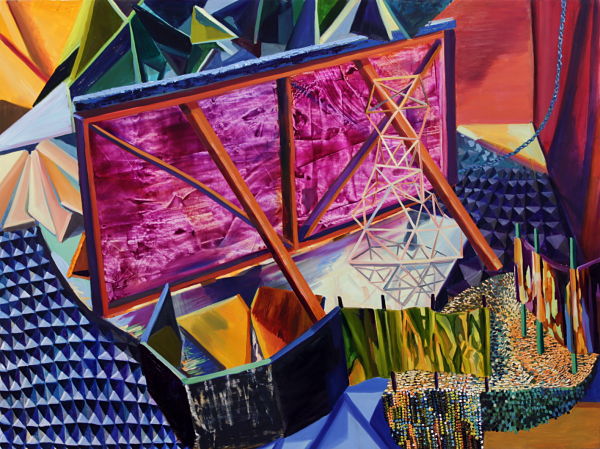 Rachel MacFarlane, The Under Study, 2012, oil on board, 35 x 47 inches
Rachel MacFarlane, The Under Study, 2012, oil on board, 35 x 47 inches
To come up for air in the MacFarlane exhibition, the portals to the real world still come down to the formal basics, like paint-handling and the deft use of colour. These the artist mercifully furnish.
by Steve Rockwell
Photo: Nicholas Metivier Gallery, 2013
*Note: the show is open January 5 – 26, 2013

